Disarmament
Disarmament is the act of reducing, limiting, or abolishing weapons. Disarmament generally refers to a country's military or specific type of weaponry. Disarmament is often taken to mean total elimination of weapons of mass destruction, such as nuclear arms. General and Complete Disarmament was defined by the United Nations General Assembly as the elimination of all WMD, coupled with the “balanced reduction of armed forces and conventional armaments, based on the principle of undiminished security of the parties with a view to promoting or enhancing stability at a lower military level, taking into account the need of all States to protect their security.”[1]

History
At the Hague Peace Conferences in 1899 and 1907 government delegations debated about disarmament and the creation of an international court with binding powers. The court was considered necessary because it was understood that nation-states could not disarm into a vacuum. After World War I revulsion at the futility and tremendous cost of the war was widespread. A commonly held belief was that the cause of the war had been the escalating buildup of armaments in the previous half century among the great powers (see Anglo-German naval arms race). Although the Treaty of Versailles effectively disarmed Germany, a clause was inserted that called on all the great powers to likewise progressively disarm over a period of time. The newly formed League of Nations made this an explicit goal in the covenant of the league, which committed its signatories to reduce armaments 'to the lowest point consistent with national safety and the enforcement by common action of international obligations'.[2]


One of the earliest successful achievements in disarmament was obtained with the Washington Naval Treaty. Signed by the governments of Great Britain, the United States, Japan, France, and Italy, it prevented the continued construction of capital ships and limited ships of other classification to under 10,000 tons displacement. The size of the three country's navies (the Royal Navy, United States Navy and Imperial Japanese Navy) was set at the ratio 5-5-3.[3]
In 1921 the Temporary Mixed Commission on Armaments was set up by the League of Nations to explore possibilities for disarmament. Proposals ranged from abolishing chemical warfare and strategic bombing to the limitation of more conventional weapons, such as tanks. A draft treaty was assembled in 1923 that made aggressive war illegal and bound the member states to defend victims of aggression by force. Since the onus of responsibility would, in practice, be on the great powers of the League, it was vetoed by Great Britain, who feared that this pledge would strain its own commitment to police its British Empire.
A further commission in 1926, set up to explore the possibilities for the reduction of army size, met similar difficulties, prompting the French Foreign Minister Aristide Briand and US Secretary of State Frank Kellogg to draft a treaty known as the Kellogg-Briand Pact, which denounced war of aggression. Although there were 65 signatories to the pact, it achieved nothing, as it set out no guidelines for action in the event of a war.[4]
A final attempt was made at the Geneva Disarmament Conference from 1932 to 1937, chaired by former British Foreign Secretary Arthur Henderson. Germany demanded the revision of the Versailles Treaty and the granting of military parity with the other powers, while France was determined to keep Germany demilitarised for its own security. Meanwhile, the British and Americans were not willing to offer France security commitments in exchange for conciliation with Germany. The talks broke down in 1933, when Adolf Hitler withdrew Germany from the conference.[5]
Nuclear disarmament


Nuclear disarmament refers to both the act of reducing or eliminating nuclear weapons and to the end state of a nuclear-free world, in which nuclear weapons are completely eliminated.
In the United Kingdom, the Campaign for Nuclear Disarmament (CND) held an inaugural public meeting at Central Hall, Westminster, on 17 February 1958, attended by five thousand people. After the meeting a few hundred left to demonstrate at Downing Street.[6][7]
CND's declared policies were the unconditional renunciation of the use, production of or dependence upon nuclear weapons by Britain and the bringing about of a general disarmament convention. The first Aldermaston March was organised by the CND and took place at Easter 1958, when several thousand people marched for four days from Trafalgar Square, London, to the Atomic Weapons Research Establishment close to Aldermaston in Berkshire, England, to demonstrate their opposition to nuclear weapons.[8][9] The Aldermaston marches continued into the late 1960s when tens of thousands of people took part in the four-day marches.
In 1961, US President John F. Kennedy gave a speech before the UN General Assembly where he announced the US "intention to challenge the Soviet Union, not to an arms race, but to a peace race – to advance together step by step, stage by stage, until general and complete disarmament has been achieved." He went on to call for a global general and complete disarmament, offering a rough outline for how this could be accomplished:
The program to be presented to this assembly - for general and complete disarmament under effective international control - moves to bridge the gap between those who insist on a gradual approach and those who talk only of the final and total achievement. It would create machinery to keep the peace as it destroys the machinery of war. It would proceed through balanced and safeguarded stages designed to give no state a military advantage over another. It would place the final responsibility for verification and control where it belongs, not with the big powers alone, not with one's adversary or one's self, but in an international organization within the framework of the United Nations. It would assure that indispensable condition of disarmament - true inspection - and apply it in stages proportionate to the stage of disarmament. It would cover delivery systems as well as weapons. It would ultimately halt their production as well as their testing, their transfer as well as their possession. It would achieve under the eyes of an international disarmament organization, a steady reduction in force, both nuclear and conventional, until it has abolished all armies and all weapons except those needed for internal order and a new United Nations Peace Force. And it starts that process now, today, even as the talks begin. In short, general and complete disarmament must no longer be a slogan, used to resist the first steps. It is no longer to be a goal without means of achieving it, without means of verifying its progress, without means of keeping the peace. It is now a realistic plan, and a test - a test of those only willing to talk and a test of those willing to act.[10]
Major nuclear disarmament groups include Campaign for Nuclear Disarmament, Greenpeace and International Physicians for the Prevention of Nuclear War. There have been many large anti-nuclear demonstrations and protests. On June 12, 1982, one million people demonstrated in New York City's Central Park against nuclear weapons and for an end to the cold war arms race. It was the largest anti-nuclear protest and the largest political demonstration in American history.[11][12]
Disarmament conferences and treaties
- 1675: Strasbourg Agreement (1675)
- 1899: Hague Peace Conference
- 1919: Treaty of Versailles
- 1925: Locarno Treaties
- 1927: Kellogg-Briand Pact
- 1932–34: World Disarmament Conference
- 1960: Ten Nation Disarmament Committee
- 1962–1968: Eighteen Nation Disarmament Committee
- 1969–1978: Conference of the Committee on Disarmament
- 1979–present: Conference on Disarmament (CD)[13]
Naval
- 1908–1909: London Naval Conference
- 1921–1922: Washington Naval Conference
- 1927: Geneva Naval Conference
- 1930: London Naval Conference leading to the London Naval Treaty
- 1935: London Naval Conference leading to the Second London Naval Treaty
Space
- 1967: Outer Space Treaty
Definitions of disarmament
In his definition of "disarmament", David Carlton writes in the Oxford University Press Political dictionary, "But confidence in such measures of arms control, especially when unaccompanied by extensive means of verification, has not been strengthened by the revelation that the Soviet Union in its last years successfully concealed consistent and systematic cheating on its obligations under the Biological Weapons Convention." He also notes, "Now a freeze or a mutually agreed increase is not strictly speaking disarmament at all. And such measures may not even be intended to be a first step towards any kind of reduction or abolition. For the aim may simply be to promote stability in force structures. Hence a new term to cover such cases has become fashionable since the 1960s, namely, arms control."[14]
References
- UN General Assembly, Final Document of the First Special Session on Disarmament Archived November 17, 2015, at the Wayback Machine, para. 22.
- Trevor N. Dupuy, and Gay M. Hammerman, eds. A Documentary History of Arms Control and Disarmament (1973).
- Marriott, Leo (2005), Treaty Cruisers: The First International Warship Building Competition, Barnsley: Pen & Sword, ISBN 1-84415-188-3
- Kellogg-Briand Pact 1928, Yale UP, archived from the original on 2012-05-09
- "The League And Disarmament: A Story Of Failure".
- John Minnion and Philip Bolsover (eds), The CND Story, Allison and Busby, 1983, ISBN 0-85031-487-9.
- "Campaign for Nuclear Disarmament (CND)". Spartacus-Educational.com. Archived from the original on 2011-05-14. Retrieved 2019-02-27.
- A brief history of CND
- "Early defections in march to Aldermaston". Guardian Unlimited. 1958-04-05.
- "Address by President John F. Kennedy to the UN General Assembly". U.S. Department of State.
- Jonathan Schell. The Spirit of June 12 The Nation, July 2, 2007.
- 1982 - a million people march in New York City Archived June 16, 2010, at the Wayback Machine
- The UN office at Geneva – Disarmament in Geneva
- disarmament: Definition and Much More from Answers.com
Further reading
- Cuthbertson, Ian, and Peter ME Volten. The Guns Fall Silent: The End of the Cold War and the Future of Conventional Disarmament (Routledge, 2019).
- Dupuy, Trevor N., and Gay M. Hammerman, eds. A Documentary History of Arms Control and Disarmament (1973), 629 pp.
- Feldman, Jonathan M. "From the From Warfare State to 'Shadow State': Militarism, Economic Depletion and Reconstruction," Social Text, 91, Volume 25, Number 22 Summer, 2007.
- Kitching, Carolyn J. Britain and the Problem of International Disarmament: 1919–1934 (Routledge, 2003.)
- Marks, Sally. The Illusion of Peace: International Relations in Europe 1918–1933 (Macmillan, 2003).
- Melman, Seymour, ed. Inspection for Disarmament (New York: Columbia University Press, 1958).
- Myrdal, Alva. The Game of Disarmament: How the United States and Russia run the arms race (New York: Pantheon, 1978).
- Marcus G. Raskin. "Draft Treaty for a Comprehensive Program for Common Security and General Disarmament," in Essays of a Citizen: From National Security State to Democracy (Armonk, New York: M. E. Sharpe, Inc., 1991): 227–291.
- Wittner, Lawrence S. Confronting the Bomb: A Short History of the World Disarmament Movement (Stanford University Press, 2009). 254pp online review
See also
External links
- Disarmament Affairs, United Nations
- Disarmament Insight Blogsite
- Organisation for the Prohibition of Chemical Weapons
- Archive of Related Writings, Seymour Melman Website
- Archive of Related Writings, Economic Reconstruction Website
- Armament and Disarmament, Stockholm International Peace Research Institute
- League of Nations conference listing
- "Naval conference", Columbia Encyclopedia